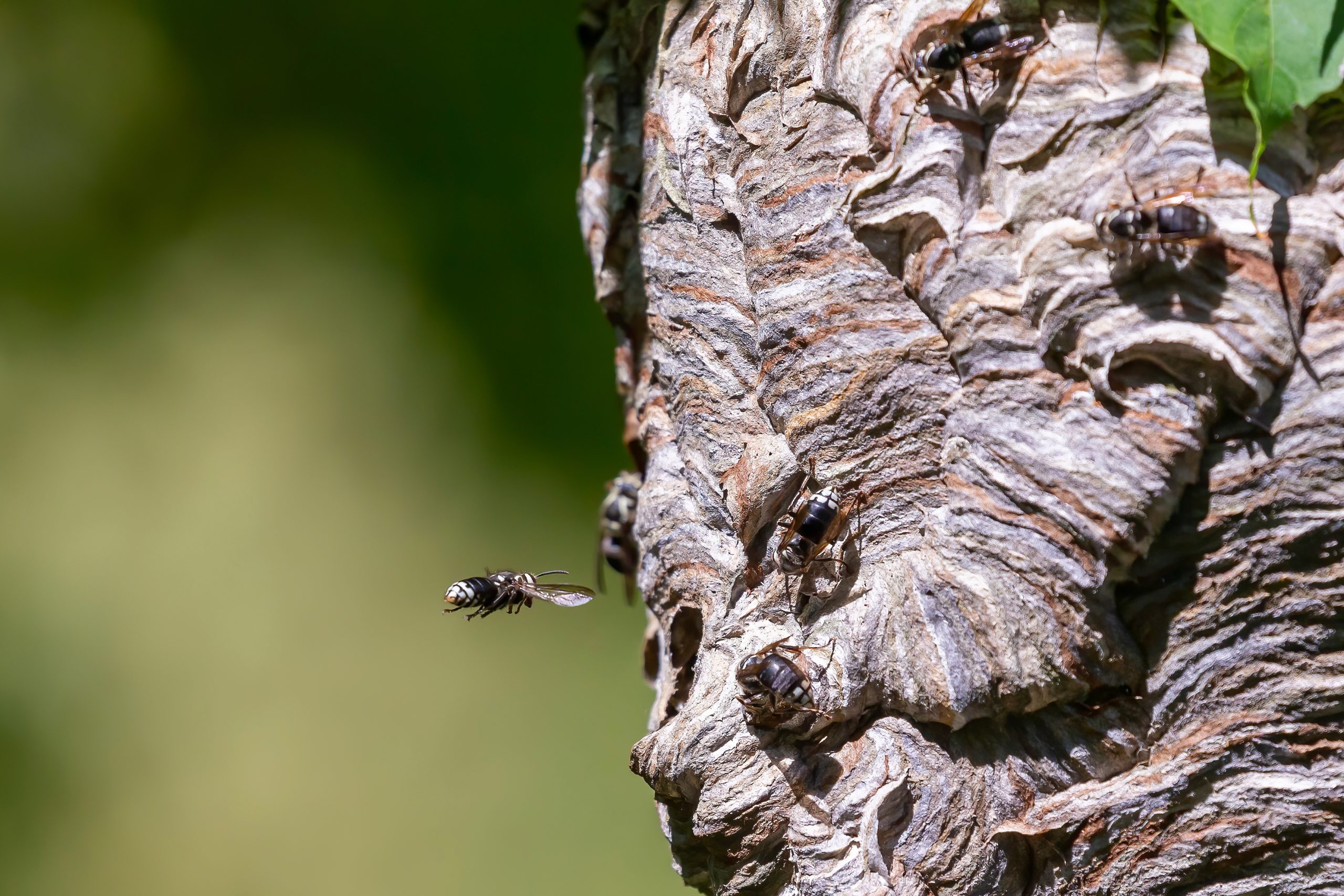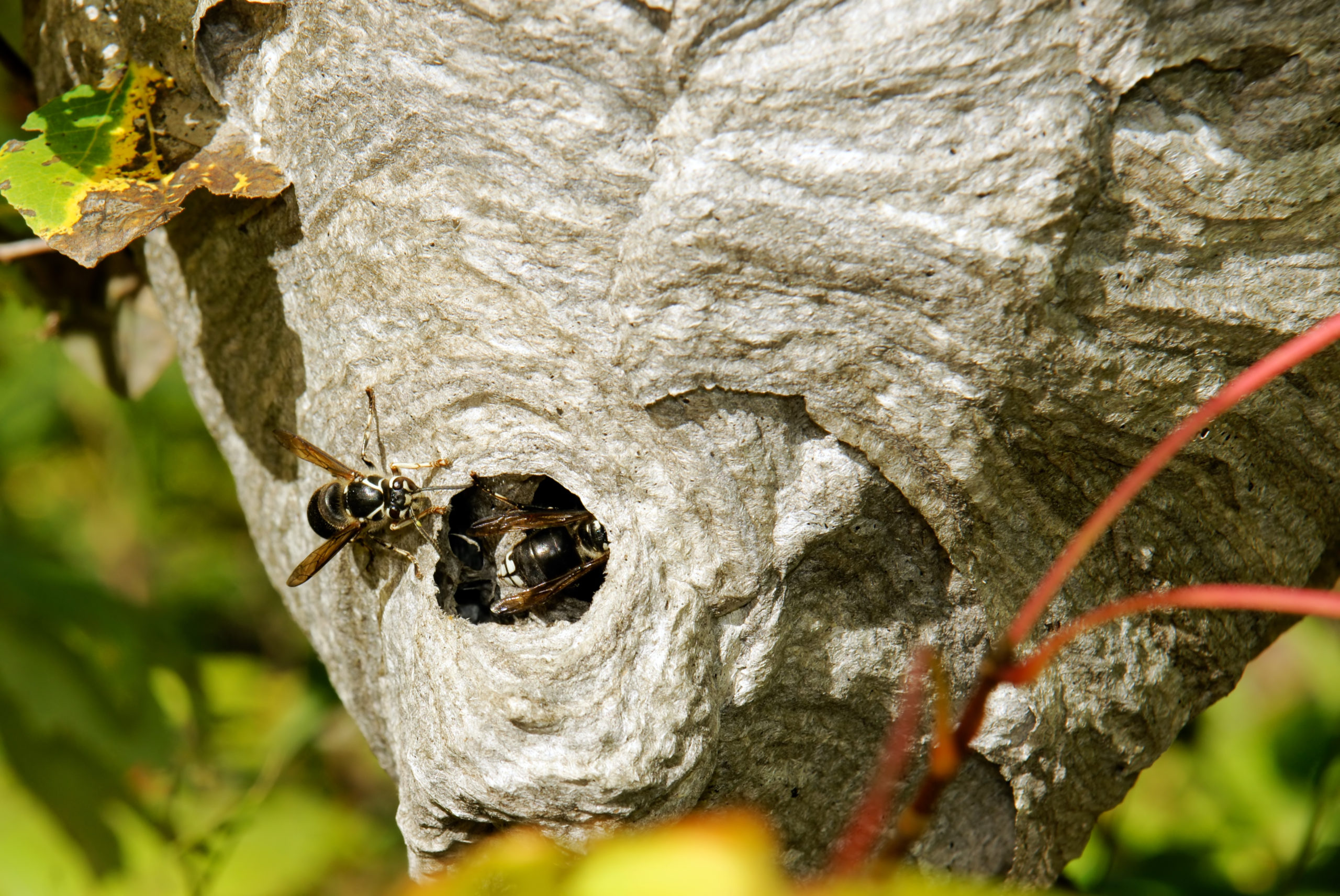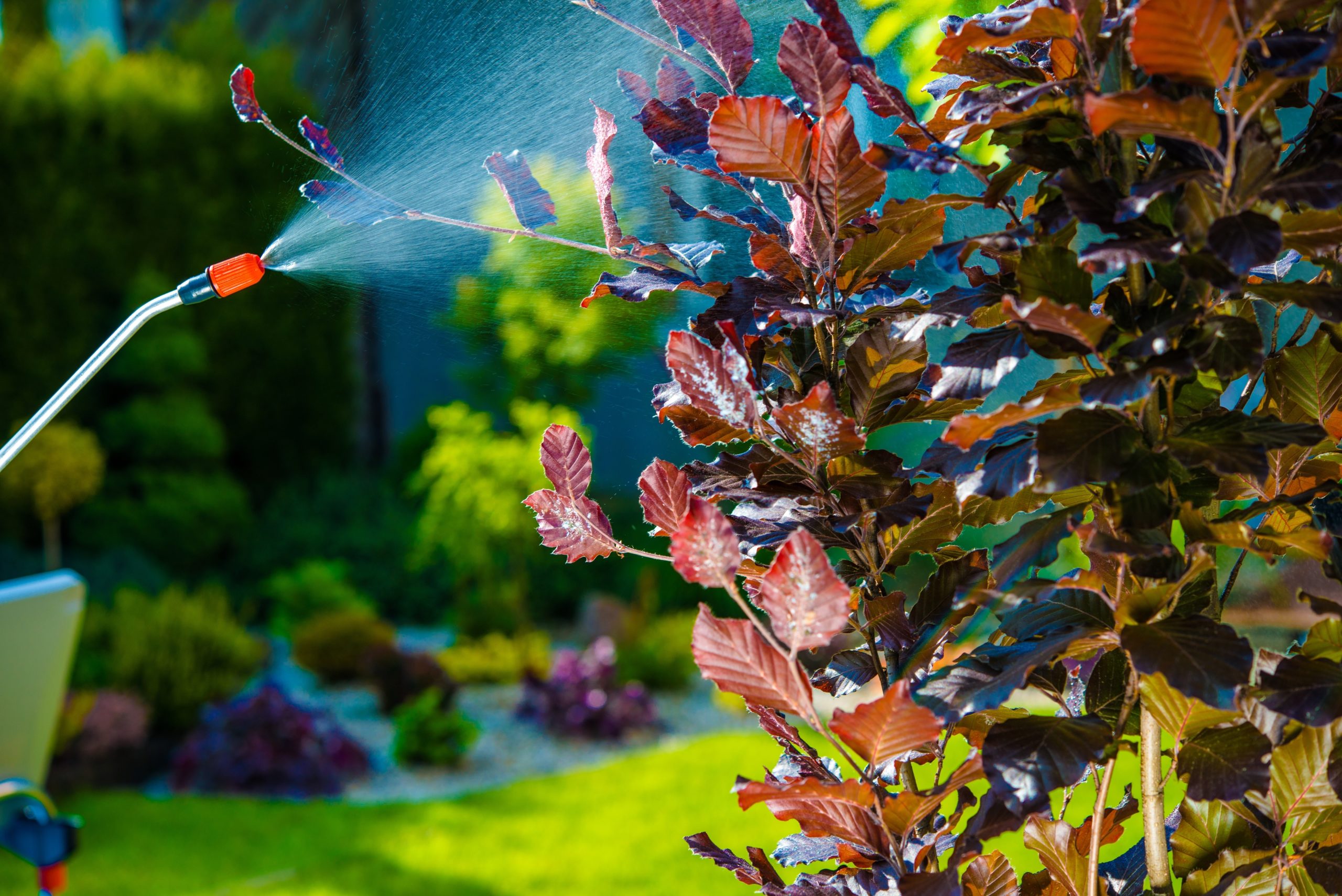Bald-Faced Hornet Bullies
Bald-Faced Hornet Bullies
The word “hornet” understandably makes some people nervous, what with the infamous “murder” hornets from the last couple of years. But just like how those insects would only pose a threat if someone got close to their nest, bald-faced hornets are not out to get us. They act like normal wasps or hornets, which is still a worrisome thought for those who fear being stung or are allergic. But considering how scary these hornets look just on a shallow level, are these hornets any worse than normal hornets? Let’s look at the basic life of a bald-faced hornet and why they are not a backyard insect we want to befriend.
Wait…They’re Not Hornets?

Technically, bald-faced hornets are not hornets, which is very deceptive. They are related to yellow jackets and seem to act like just about any wasp or hornet, so it does not make too much of a difference what they are called. The “bald-faced” part of their name relates to their appearance, and it is accurate. They are mainly black with an ivory-colored face and some light stripes going from their abdomen up to their head. Bald-faced hornets are larger than yellow jackets, measuring about half an inch long with queens that are slightly larger. They have 6 legs and 2 antennae like most common insects, and the overall body shape of a wasp. But the easiest way to distinguish this pest from other stinging insects is by their light faces, since that is definitely a unique feature that their stinging brethren do not share.
The queen of a bald-faced hornet colony is royalty for a reason; she is the reason the colony has a home and a high population in the first place! The queen will overwinter in a sheltered place after mating with male drones, then emerge in the spring to start a new nest and colony. Before the female workers are around, the queen will make the cells of the nest, defend her home from enemies, lay her eggs, and feed the hatched grubs. Then the mature female workers take over every duty except for the egg-laying, since the queen is the only bald-faced hornet capable of reproducing. There are usually about 100 to 400 workers per nest, with the major population increase in mid-summer. Bald-faced hornet colonies can be found in most regions of the U.S., but they seem to be the most abundant in the southeastern states.
By-the-Book Beneficial Diet

Whether they’re a wasp or a hornet, these insects have a pretty typical diet of either party. They are technically beneficial for a couple of reasons. The first is that they are pollinators. Bald-faced hornets drink a lot of nectar, which means they pollinate a lot of flowers as each flower’s pollen collects on their bodies. They can be found on bright flowers like any other stinging insect, but the sweet nectar is not typically the food they bring back to their colony.
Bald-faced hornets, like meat bees, crave protein and desire it for their growing grubs back in the nest. The protein comes in the form of other insects, which is the second reason these pests can be considered to be beneficial. The workers fly out and search for smaller insects to bring back to the nest, and many of these are pests that would otherwise frustrate us and eat our gardens. Some of the favorites include caterpillars, flies, and blowflies, all of which can seriously damage plants. Bald-faced hornets look for live insects to catch and kill, which is convenient considering they are already in gardens gathering the nectar. Protein and sugar are the two major food groups for these eusocial insects, so their high-flying nests need to be in close proximity to plenty of greenery in order to provide for the rapidly-growing colony.
Home in a Hovel

If you have never had the displeasure of seeing a bald-faced hornet nest, just imagine a massive wasp nest hanging from a tree and the nightmarish scenario paints itself. Bald-faced hornets like to keep their nests high up, about 10 to 12 feet off the ground! They hang the nest from something sturdy, which usually means a tree limb, pole, house siding, or a tall shrub. It is gray and papery in texture, with tons of individual combs inside. The material is achieved by the workers chewing a ton of wood into a soft pulp, then arranging it into a secure structure. This can be pretty damaging to the plants that surround the nest since the pests will strip their wood for this purpose. The nest is almost entirely enclosed, save for a hole on the bottom near a side for the busy workers to enter and exit.
These nests are no joke and are not an easy thing to just knock down from whatever material it hangs from. First of all, please do not try to remove a nest on your own! These insects are extremely territorial and will not hesitate to swarm and sting an enemy repeatedly. It is a dangerous mission without the proper protection and professional equipment. The first sign of an infestation is seeing workers fly around, looking like they are gathering materials. But secondly, this monstrosity can be the size of a basketball when the colony has had enough time to expand the nest and secure the interior. College dorm rooms could learn from these nests, since the walls here are super thick and about 3 to 4 layers deep! This is why a professional is needed for this daunting task; it would take more than a quick tap-and-run on this beast for it to come down and be destroyed.
A Swarming Life for Me

So, now we come to the question of whether or not these pests are any worse than the average wasp or hornet. The short answer is “no,” so long as you don’t do anything to annoy them. Any kind of stinging eusocial pest is defensive, but some are more aggressive than others. Bald-faced wasps are known to sting anyone who comes within about 3 feet of the nest, especially if there is some kind of disturbance. This is really the only time they are aggressive, as the workers will do anything to protect the nest. Some people consider these to be the most dangerous or angry wasps/hornets, but that isn’t necessarily true. As long as you don’t go near their nest, you shouldn’t have anything to worry about.
The main concerns with these pests comes from two lines of thinking: bald-faced hornets can sting repeatedly, and the people who are allergic to stings. Since their stingers are smooth, unlike bees, bald-faced hornets keep their stingers and can use them as many times as they want. When there is a threat to their home or colony, an alarm pheromone is released by the lookout that alerts the rest of the workers to the enemy. This can mean an unimaginable number of stings if the victim does not evacuate the area immediately.
As for those who are allergic to stings, they are typically on high alert in these areas anyway, but it is a good idea to keep an eye out for massive nests nearby. People who have been stung by bald-faced hornets (not necessarily allergic) report that the pain is instantaneous and worse than a bee sting. There is often swelling, itching, soreness, and redness associated with the sting areas, so you will definitely know if you have been stung. Oddly enough, there is a high number of bald-faced hornet stings that occur on a person’s face, which sounds awful in every way. If you have been stung by these pests and experience symptoms, especially if you are allergic, please seek medical attention immediately.
Pest Control Can Prevent These Bald-Faced Fiends

Bald-faced hornets, and stinging pests of any kind, generally like to stay outside in their massive nests. But when the temperature starts dropping in the fall, they like to seek shelter for their male drones and queens before winter sets in. Sealing all cracks and holes in your house will prevent them from using it as a vacation home when it’s chilly outside. And, as we always say, fixing any leaks and keeping food sealed will take away any temptation for these pests to invade for our water and food.
Of course, a giant hornet or wasp nest in your backyard is never something that people wish for. It can turn going out back to water the plants into a tense mission where all of your attention is focused on avoiding the watchful eyes of the colony. If you see workers flying near the nest and using the entrance point often, it is a fully active nest. Singing insects will do whatever it takes to defend their home, which means attacking any potential threat in swarms, thanks to the efficient communication through threat pheromones. But our pest control services are here to eliminate any kind of stinging insect from your yard, no matter how big their nest is. Our team of experienced technicians has the proper equipment and protection to safely remove nests and provide EPA-approved treatments for the colony. Contact us today to learn more about our wasp/hornet services and how we can keep your yard from becoming a haven for sly stingers.
Citations
Baker, J. (2021, June 22). Bald-faced hornets in landscapes. NC State Extension. Available at https://content.ces.ncsu.edu/bald-faced-hornets (Accessed on August 2, 2022).
Bald-faced bully. (2019, August 7). Rescue. Retrieved August 2, 2022, from https://www.rescue.com/latest-buzz/outdoor-pests/bald-faced-bully/#
Bald-faced hornet. (n.d.). Missouri Department of Conservation. Retrieved August 2, 2022, from https://mdc.mo.gov/discover-nature/field-guide/bald-faced-hornet
Bald-faced hornets. (2021, December). Iowa State University Horticulture and Home Pest News. Retrieved August 2, 2022, from https://hortnews.extension.iastate.edu/bald-faced-hornets
Bald-faced hornets. (n.d.). Pest World. Retrieved August 2, 2022, from https://www.pestworld.org/pest-guide/stinging-insects/bald-faced-hornets/
8 Creative Ways to Have a Pest-Free Fourth of July
8 Creative Ways to Have a Pest-Free Fourth of July 8 Creative Ways to Have a Pest-Free Fourth of July Summary: The Fourth [...]
A Simple Guide to Preventing Stinging Pests
A Simple Guide to Preventing Stinging Pests A Simple Guide to Preventing Stinging Pests Summary: Stinging insects are more active in warm weather, [...]
These 10 Natural Mosquito Repellents Can Actually Help
These 10 Natural Mosquito Repellents Can Actually Help These 10 Natural Mosquito Repellents Can Actually Help Summary: Natural mosquito repellents are easier to [...]
How to Get Rid of Carpet Beetles
How to Get Rid of Carpet Beetles How to Get Rid of Carpet Beetles Summary: Carpet beetles are sneaky pests that don’t usually [...]
How Do Roaches Affect Asthma and Allergies?
How Do Roaches Affect Asthma and Allergies? How Do Roaches Affect Asthma and Allergies? Summary: It’s no secret that pests impact human health, [...]
These 5 Carnivorous Pests Might Surprise You!
These 5 Carnivorous Pests Might Surprise You! These 5 Carnivorous Pests Might Surprise You! Summary: There are many eco-friendly ways to prevent pests, [...]

